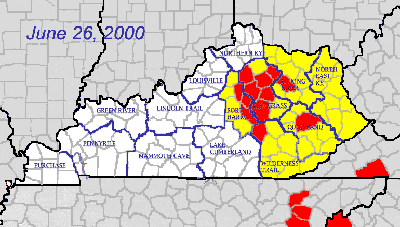 Blue Mold Watch for Wilderness Trail and Quicksand Extension Areas of Kentucky
Blue Mold Watch for Wilderness Trail and Quicksand Extension Areas of Kentucky
 Blue Mold Watch for Wilderness Trail and Quicksand Extension Areas of Kentucky
Blue Mold Watch for Wilderness Trail and Quicksand Extension Areas of Kentucky
Blue Mold Watch for the following Kentucky Extension Areas: Bluegrass, Ft Harrod, Licking River, Northeast Kentucky, Quicksand, and Wilderness Trail
Blue mold is active at low levels in eastern and central Kentucky. I suspect it is active in all counties in eastern Kentucky, but activity has been confirmed only in the following counties: Bath, Breathitt, Bourbon, Clark, Fayette, Garrard, Jessamine, Madison, Nicholas, Rockcastle, Scott, and Woodford.
It is difficult to find blue mold at this stage of development, so usually it is the experts that are finding it (mainly plant pathologists and agronomists). All confirmed field activity has involved a few scattered lesions, ranging from about 1 to 17 lesions/10,000 plants, and averaging 1 lesions/5000 plants. I suspect that high temperature has played a major role in slowing development, because nearly all large lesions have been found on the cooler areas of the leaf, either on the north side of the plant or with shade from the west. On the east and south sides of plants, lesions are seldom found, and when present they are much smaller - tiny flecks to 5 mm in diameter. In general, sporulation has been very light, but a few lesions have sporulated heavily.
Blue mold is probably very active in some plant beds or greenhouses. The most active cases found thus far involved transplants being shipped from central Kentucky to east Kentucky. Local lesions and systemic infections were present in those.
Eastern Tennessee, western North Carolina, and western Virginia also have active blue mold in burley tobacco. New activity has been reported in Canada and the Connecticut Valley.
Control Efforts:
During a Watch or Warning, controls should be put in place. The following controls are needed in the Watch/Warning areas.
Transplant Operations: DESTROY IMMEDIATELY ALL TRANSPLANTS NOT TO BE USED FOR TRANSPLANTING. Preventive fungicide sprays (Ferbam or Dithane) made at weekly intervals should be maintained in all transplant production systems to aid in the control of fungal diseases including blue mold. It is important to eliminate all transplants that are not needed. Overlapping of transplant production and field production is a key factor in blue mold development. Holding transplants is an excellent way to get things started, especially during seasons when the blue mold potential has been very low and the greatest threat comes from airborne inoculum arriving from flue-cured epidemics - just what we are seeing now.
Consider the following concerning transplants in the rest of Kentucky.
1. Keep all surplus plants sprayed weekly with fungicides - Ferbam or Dithane.
2. Any plants not sprayed within the past 7 days should be destroyed ? killed.
3. Move the surplus transplants to the communities where they are needed, so that the overlap and risk are in the community with the need for plants rather than those without the need. However, never move transplant from a watch/warning area to other tobacco producing areas of the state or nation.
Fields: Foliar fungicide sprays made at this time can greatly reduce the potential for blue mold building up in the field. While the level of activity is low and the leaves in the lower portions of the plant can be easily reached, fungicide applications with Acrobat MZ will eliminate blue mold. The systemic aspect of this fungicide makes it especially valuable in blue mold control early in the epidemic. Preventive field applications of fungicides are especially needed at this time for sites set with highly susceptible varieties in foggy sites, especially those in rotated land (due to superior growth potential) and creek or river bottoms. Use Acrobat MZ at 2.5 lbs /100 gallons of water, adjusting the concentration and volume of fungicide to the stage of growth, according to the label. Repeat the applications at weekly intervals.
The forecast will probably be updated a lot this week. For current status, check the KY Blue Mold Warning System.
![]() http://www.uky.edu/Agriculture/kpn/kyblue/kyblue.htm
http://www.uky.edu/Agriculture/kpn/kyblue/kyblue.htm
Tobacco aphid numbers are increasing rapidly in fields that were set 4 or more weeks ago. Top priority should be given to checking the earliest set fields because this is where aphid numbers have had the longest opportunity to build. There is a tremendous increase in aphids during weeks 4 to 10 after transplant; this is when yield losses occur.
Treat when colonies or clusters of aphids are found on 20% or more of the plants in a field. The goal at this point is to protect the developing bud leaves. If aphids are present on 1/4 long leaves and continue to remove sap from them, the leaves will not expand to their potential nor will they have the weight necessary for top yields. Use of the treatment guideline will help to protect these important leaves by keeping aphid numbers below damaging levels.
Hornworms are chewing round holes in leaves on the upper 1/3 of plants now. Look for them on the underside of tobacco leaves. A single hornworm can eat most on a small plant so it is well worth the time to look for then while checking plants for tobacco aphids.
Orthene (also sold under the names Bracket and Acephate) or Golden Leaf (also sold as Thiodan or Endosulfan) are broad spectrum insecticides that can be used when both aphids and hornworms/ budworms or other insects are at treatable levels.
These, or any of a variety of specific insecticides for caterpillars (Agree, Dipel, Lepinox, Tracer) can be used in fields where they are the only pest present.
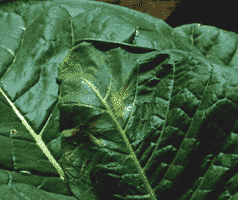 Stink bug damage has been very apparent on corn
(see next article) and injury can be showing up on
tobacco as well. Stink bugs use their piercing sucking
mouthparts to remove plant sap. Saliva, injected as
they feed, can cause collapse of surrounding tissue.
On hot, suuny days, this wilted portion of the leaf can
be scalded, turning yellow and dying. Symptoms
appear on individual, usually upper, leaves of plants
scattered across a field. The damage often is more
intense along field margins or border rows and more
widely spaced over the middle of the field.
Stink bug damage has been very apparent on corn
(see next article) and injury can be showing up on
tobacco as well. Stink bugs use their piercing sucking
mouthparts to remove plant sap. Saliva, injected as
they feed, can cause collapse of surrounding tissue.
On hot, suuny days, this wilted portion of the leaf can
be scalded, turning yellow and dying. Symptoms
appear on individual, usually upper, leaves of plants
scattered across a field. The damage often is more
intense along field margins or border rows and more
widely spaced over the middle of the field.
Adult stink bugs are good fliers and will move from plant to plant as they feed. Leaf collapse is not very noticeable until some time after the feeding has occurred, so application of an insecticide will not be worthwhile.
For more information on tobacco insect management, see the Insect Management Recommendations at:
![]() http://www.uky.edu/Agriculture/PAT/recs/rechome.htm
http://www.uky.edu/Agriculture/PAT/recs/rechome.htm
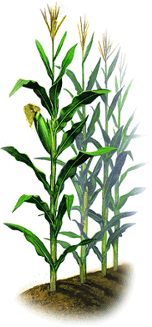
There has been a number of insect related problems in corn that growers have been seeing occasionally in fields this year. Stink bug damage is apparent in some fields and there have been several recent reports. Although some producers are now seeing the symptoms of the damage, the plants were attacked by stink bugs several weeks ago and the stink bugs are long gone.
Plants appearing "buggywhip?like", with the youngest leaves not able to completely emerge from the whorl, excessive tillering of the plant, or plants showing kernel development on the tassel is characteristic of stink bug damage. Corn planted under reduced tillage practices following small grains or soybeans may be showing some of this characteristic but unusual stink bug damage. Corn is most susceptible from seedling through the four leaf stage. Stunted plants with malformed leaves, may tiller excessively or die. Plants that tiller excessively will not yield grain.
Stink bug damage can be confused with herbicide damage. Stink bug damage is usually sporadic throughout the field, while herbicide/insecticide damage often affects the entire field. Often there is a series of holes in the leaves that reveal where the stink bugs feed on the plant. The holes are characteristic of sink bug damage and are very different from holes made by other corn pests. Typically, there are four holes in a straight line across the leaf. These holes are irregular in shape and do not have a sharp margin as you would observe with corn borers or fall armyworm. The tissue around these holes is yellowed. While stink bugs have sucking mouthparts, they inject enzymes into the plants which cause the tissue around feeding sites to dissolve. Unfortunately, stink bug damage appears noticeable long after the pest has come and gone.
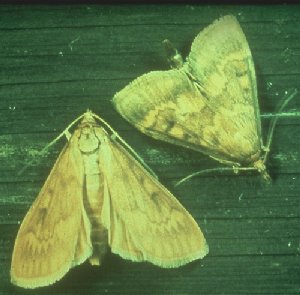 First generation European corn borer moths are active
across the state. While first generation infestations
were low to moderate, later plantings are more likely
to be attacked by the second generation. Small holes
in the leaves that may or may not go all the way
through the leaves are indications of corn borer
feeding. With low corn prices, growers should
monitor their fields regularly to prevent economic
losses this year. In the western portion of the state,
southwestern corn borer has also been active and
infestations are comparable to those of the last two
years.
First generation European corn borer moths are active
across the state. While first generation infestations
were low to moderate, later plantings are more likely
to be attacked by the second generation. Small holes
in the leaves that may or may not go all the way
through the leaves are indications of corn borer
feeding. With low corn prices, growers should
monitor their fields regularly to prevent economic
losses this year. In the western portion of the state,
southwestern corn borer has also been active and
infestations are comparable to those of the last two
years.
For more information about corn pests, visit
"Insect Management Recommendations".
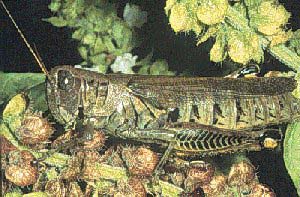 I continue to receive questions from producers,
consultants and ag store managers concerning
grasshopper feeding in corn. It should be obvious
that not all of these problems are connected with
drought stress. I suspect there is a generally larger
population of grasshoppers that have survived the
winter. I expect that the outbreaks will remain
scattered but intense. Each field will have to be
evaluated separately. Additionally, unlike most
other insect pests in Kentucky grasshopper
populations can reappear in the same field after one
population has been controlled.
I continue to receive questions from producers,
consultants and ag store managers concerning
grasshopper feeding in corn. It should be obvious
that not all of these problems are connected with
drought stress. I suspect there is a generally larger
population of grasshoppers that have survived the
winter. I expect that the outbreaks will remain
scattered but intense. Each field will have to be
evaluated separately. Additionally, unlike most
other insect pests in Kentucky grasshopper
populations can reappear in the same field after one
population has been controlled.
There is no clear cut damage threshold for control of grasshoppers on corn. Generally these are pest in the late season. However, one can infer from working with armyworms (which also remove leaf tissue) that insecticide application might be warranted if on average plants suffer 35-50% defoliation. This will appear to the observer as MASSIVE damage.
Additionally, grasshoppers will sometimes feed on silks. This is a much more dangerous condition. In this situation treat the grasshoppers just like any other silk feeding insect. If fresh green silks are eaten back to within ½ if of the ear tip control should be considered. After pollination is complete, it does not matter if the silks are eaten, so no control would be needed any longer.
Most insect outbreaks in Kentucky can be control with a single application of insecticide, and a number of common insecticides are available for use. See ENT-16, Insecticides for Corn?2000. You may obtain a copy of this from your county Extension office or by visiting the 2000 INSECT MANAGEMENT RECOMMENDATIONS FOR FIELD CROPS AND LIVESTOCK website at: http://www.uky.edu/Agriculture/PAT/recs/rechome.htm
While one application may control your grasshopper problems, producers should be aware that a re? infestation may reoccur in the same field. Grasshoppers are very mobile and will move when their food source becomes inadequate. So, you may find a second outbreak in the same field sometime after control was though to have been achieved. This is a result of hopper moving into the field and not from lack of control or a second generation of hoppers.
During the last several weeks, I've visited corn fields in the Bluegrass, Green River, Lincoln Trail, Mammoth Cave, and Pennyrile Extension Areas, as well as diagnosed samples received at the UK Plant Diagnostic Lab.Lexington. Some notes on my observations are provided below.
Gray Leaf Spot.
Levels of this disease are low in the fields I examined.
Although the disease was present on the lowest
leaves of some fields (particularly no.till, continuous
corn), levels were well below spray thresholds. (For
those interested, susceptible hybrids may benefit from
a fungicide application if at least 50% of plants in the
field have gray leaf spot lesions on the third leaf
below the ear leaf any time up to silking. For crops
that are not yet tasseling, this is commonly the V9 or
V10 leaf position.)
Several factors have probably kept levels of this disease low. Last year's drought suppressed the disease in most fields, which probably reduced levels of primary inoculum. Early planting this year and dry weather during much of the past 4.6 weeks have also helped suppress the disease. Recent rains and warm, humid weather should help accelerate disease progress in many locations, but at this stage I do not expect damaging levels of gray leaf spot in most areas. Late.planted crops should be monitored closely for the disease, especially those under continuous, no.till corn and those with frequent fogs.
Common Rust.
It is possible to find pustules of common rust on
leaves up and down the plant in many fields. These
pustules vary in appearance. They can look like
small, elongate, powdery cinnamon brown blisters
that have erupted onto the upper leaf surface.
Commonly, many of the pustules look much like gray
leaf spot lesions, in that they are tan necrotic spots
with a very thin yellow border. Examine these spots
with a hand lense for the blister.like pustules of
common rust. Although common rust appeared early
this season and is even present on leaves above the
ear in some fields at this time, seasonably high
temperatures of summer and normal leaf maturation
should slow further disease development.
Virus Complex.
A sample arrived in the diagnostic lab with plants
having classic symptoms of maize dwarf mosaic virus
and maize chlorotic dwarf virus. The symptoms were
associated closely with areas of the field highly
infested with rhizome johnsongrass, which is typical
of the corn virus complex. The laboratory analyses of
these samples are still pending, but be aware of
possibility of occasional virus symptoms in
susceptible hybrids in areas of rhizome johnsongrass.
Since the appearance of these symptoms sometimes
coincides with the application of postemergence
herbicides, those are sometimes incorrectly blamed
for causing the symptoms.

 The wedge-shaped yellowing of tips of alfalfa leaves
is showing up clearly in spring-seeded alfalfa. Potato
leafhoppers are plentiful and the visible symptoms of
their feeding indicate that most of the injury has been
done on this cutting. Also, symptoms were not
apparent but leafhoppers were above treatable levels
for alfalfa harvested 10 days ago.
The wedge-shaped yellowing of tips of alfalfa leaves
is showing up clearly in spring-seeded alfalfa. Potato
leafhoppers are plentiful and the visible symptoms of
their feeding indicate that most of the injury has been
done on this cutting. Also, symptoms were not
apparent but leafhoppers were above treatable levels
for alfalfa harvested 10 days ago.
For spring-seeded fields, harvest is the best option if 30% or more of the plants have buds. Adult leafhoppers will leave the field as the cut alfalfa wilts. The wingless nymphs will perish because they cannot tolerate the hot, dry conditions and lack of tender tissue in the stubble.
Treatment may pay a dividend in fields that have been harvested within the last 7 to 10 days. See ENT-17, 2000 Insecticide Recommendations for Alfalfa, Clover, and Pastures, or "Insect Management Recommendations" for information on evaluating fields and for control options.
Soybean Cyst Nematode (SCN) is arguably the most serious disease pest of soybean in Kentucky. This is true for both full season and doublecrop soybean. Concerns over SCN tend to ebb and flow, and this appears to be a down time. Much of this, I believe, has to do with the rather depressing economic situation. However, I have also heard some farmers comment that because of the drought last summer, SCN will be less of a problem this year. This is an absolutely wrong assumption.
SCN is a survivor, and based on our research plots last year, SCN had only limited difficulty reproducing on drought-stricken soybean crops. Numbers were down slightly, but net population gain on susceptible crops was the rule rather than the exception. The main point is that SCN management programs should not be altered because of last season's drought. This is true even for doublecrop fields that were not harvested last season. Regarding SCN and non-host crops, our data show last season's drought had little additional effect on reducing SCN populations under those crops. Again, the point is to maintain SCN management programs as usual and do not become complacent.
One final point. We have previously shown that, when a SCN-susceptible soybean crop is planted directly into wheat stubble (i.e., no-till), SCN populations tend to be significantly lower at the end of the season, compared to if that same soybean crop had been planted into tilled soil, with wheat stubble, or no-till, without wheat stubble (e.g., late planted soybean behind corn). We call this the "residue effect". Put simply, during the course of a season, SCN reproduction appears to be adversely impacted by the presence of concentrated amounts of wheat stubble (such as exists in a no-till field following wheat harvest) on the soil surface. However, our studies confirmed that this "residue effect" does not take place until later in the season and, thus, the impact on SCN numbers is not evident until the end of the season. Because the key factor which determines the potential for SCN damage to soybean is the number of SCN eggs/juveniles at planting, the residue effect will be of no value in limiting crop damage to the current soybean crop. In fact, the only real advantage of the "residue effect" is in regards to the long term management of SCN in a particular field. Specifically, the lower the SCN population in a field, the less time and effort will be required to reduce that population to below the damage threshold using resistant soybean and non-host crops. The main point here is to realize that SCN will damage soybean in ALL situations as long as SCN levels are above threshold and a susceptible soybean is grown. The only wild card is the amount of damage. It is generally well accepted that a stressed soybean crop will be damaged to a greater degree than will a stress-free crop at the same SCN population at planting.
By John Hartman
Powdery mildew has for several years been the most prevalent disease of flowering dogwoods in Kentucky. We made these same observations about dogwood powdery mildew last year in late June, and they echo what we have been observing for the past several years. It has been frequently observed that there is a pronounced difference in susceptibility between individual dogwood trees. On the most susceptible individuals during the past week or two, symptoms have progressed rapidly and signs of the fungus (the white powdery growth) have become more visible. A week or two ago, a mottled yellowing of the leaves was the primary symptom, and signs of the fungus were mostly only visible under the microscope. Now, dead patches are appearing on the leaf blades, new growth is showing more distortion, and the fungus is more visible.
Based on our research on landscape dogwoods, four applications of fungicide made at three week intervals beginning the first of June provide good control of powdery mildew. Thus, if fungicides are being used to manage powdery mildew on susceptible dogwoods, the second application would have just been made. Follow-up sprays made in mid-July and early August would suffice to manage the disease until the end of the season. Fungicides effective for dogwood powdery mildew management include azoxystrobin (Heritage), fenarimol (Rubigan), myclobutanil (Eagle, Immunox), thiophanate-methyl (Cleary's 3336), and triadimefon (Bayleton). Individual dogwoods that have been observed in the past to be more tolerant to powdery mildew probably do not need fungicide applications.

Field crop samples this past week have included stinkbug injury and nutritional problems on corn; Rhizoctonia and Fusarium stem rots on soybean; black shank, soreshin, target spot, angular leaf spot, and viruses (particularly tomato spotted wilt virus and tobacco etch virus) on tobacco. We have also confirmed the first case of tobacco blue mold in Kentucky this year--see other information in this issue of Kentucky Pest News and on the Kentucky Blue Mold Warning System web page.
On fruits and vegetables, we have seen a number of diseases, particularly foliar and stem/vascular problems, including frogeye leaf spot on apple; scab on pecan; black rot (foliar lesions) on grape; Mycosphaerella leaf spot on strawberry; Rhizoctonia and Fusarium stem rots on bean; rust and smut on sweet corn; bacterial wilt on squash and cantaloupe; pollination problems on squash; bacterial speck, Fusarium stem rot, Fusarium wilt, walnut wilt, bacterial wilt, and tomato spotted wilt virus on tomato; bacterial spot on pepper; and Alternaria leaf blight and black root rot on watermelon.
On ornamentals, we have seen Pythium root rot on chrysanthemum; Rhizoctonia stem rot on impatiens, marigold and petunia; brown patch on fescue; Botrytis blight on rose; powdery mildew on dogwood; and Entomosporium leaf spot on photinia.

| UKREC-Princeton, KY, Jun 16 - 23, 2000 | |
| Fall Armyworm | 5 |
| True Armyworm | 40 |
| Corn Earworm | 5 |
| European Corn Borer | 2 |
| Southwestern Corn Borer | 17 |
The Woody Landscape Plant Maintenance and Pest Management Workshops for this year have been scheduled. The workshops, repeated at three locations, will explore woody plant health from the perspective of diseases, insects, environmental extremes, and diverse cultural insults that woody plants often endure. The morning will consist of classroom instruction by University of Kentucky faculty in a small class setting covering topics such as plant health care benefits, managing landscape plant diseases, insects, and cultural practices and mitigating environmental insults. The afternoon session consists mainly of field diagnosis exercises. These intensive hands?on workshops will benefit beginning and experienced arborists alike.
The dates and locations of the plant health care
workshops are:
July 18, Fayette County Extension Office,
Lexington
August 1, Hopkins County Extension Office,
Madisonville
August 3, Louisville Zoo, Louisville
Each of the plant health care workshops will take place from 8:30 am - 4:30 pm. The workshop registration fee is $45.00, which includes lunch. Additional optional educational materials such as the ISA publication on Plant Health Care for Woody Ornamentals, woody ornamental plant disease, insect, and identification manuals, and a hand lens are also available with the registration.
Registration materials are available from Dr. Bill Fountain, U.K. Department of Horticulture, N-318 Agricultural Science North, Lexington, KY 40546- 0091; Telephone 859-257-3320; Fax 859-257-2859; E-mail wfountai@ca.uky.edu wfountai@ca.uky.edu or from Ruth Erskine, KAA Executive Director, 548 East Pike, Cynthiana, Ky 41031; Telephone 859-235-0106. The plant health care workshops are sponsored by The Kentucky Arborists Association (KAA), International Society of Arboriculture (ISA), and the Kentucky Cooperative Extension Service.

Lee Townsend
Extension Entomologist